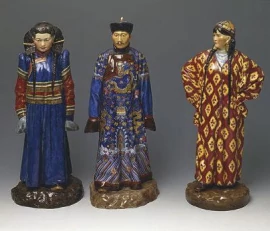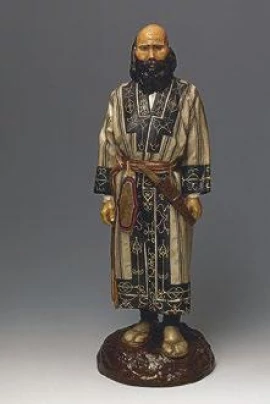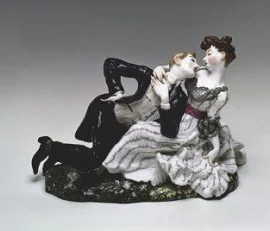1894-1917
REIGN OF NICHOLAS II AND RUSSIAN ART NOUVEAU. PRE - REVOLUTION TIME.




During the reign of the last Russian Emperor Nicholas II (1894–1917), thanks to the technical innovations of the previous period, the plant experiences state samples in technical and technological respects. In 1907 Emperor Nicholas II initiated a production of the Peoples of Russia collection, which became the largest sculptural series in the history of Russian artistic porcelain. The leadership of the project was entrusted to the eminent sculptor and theatrical decorator Pavel Kamensky. Originally the project comprised 400 figurines, but after a scrupulous work a decision was taken to depict 73 peoples, i.e. 146 separate male and female figurines in national costumes. Among the best sculptural pieces of this period are the small, elegantly coquettish figurines of Lady with a Mask, Lovers, On a Boulder, executed for the factory by Konstantin Somov, an artist of the World of Art society. This art union with its program of aristocratic aesthetics, cultivating a noble aroma of the bygone ages, played a prominent part in the cultural life of Russia at the beginning of the twentieth century. With the appointment of a new director, Nikolay Strukov, the influence of the World of Art Union on the porcelain factory increased. Strukov invited the artist and architect Yevgeny Lanceray, a member of this circle, to supervise creative activities at the enterprise and Lanceray, in turn, attracted to the factory the sculptor Vasily Kuznetsov and his assistant Natalia Danko. Among the works worthy of special attention, one should point out the portraits of the ballet dancers Anna Pavlova and Tamara Karsavina created by the sculptor Serafim Sudbinin. The statue of Karsavina, having a single point of support, the ballerina’s leg en pointe, was then the only example in the world. The war of 1914–17 sharply changed the production profile : the production of artistic porcelain wares was reduced to a minimum and the small amount produced was sold by the Cabinet at charity parties for the benefit of royal military hospitals. Theonly pieces manufactured in large quantities, were Easter eggs, intended for “Christening with soldiers at the front”. Nicholas II’s last visit to the factory in December 1916 outwardly looked decently. His Majesty was acquainted with traditional presentation pieces of the imperial family for Christmas; a regular commission for Easter eggs was taken.
Russia was on the threshold of the revolutionary year 1917…


